Raleigh, Pilton

The historic manor of Raleigh, near Barnstaple and in the parish of Pilton, North Devon, was the first recorded home in the 14th century of the influential Chichester family of Devon. It was recorded in the Doomsday Book of 1086 together with three other manors which lay within the later created parish of Pilton. Pilton as a borough had existed long before the Norman Conquest and was one of the most important defensive towns in Devon under the Anglo-Saxons. The manor lies above the River Yeo on the southern slope of the hill on top of which exists the ruins of the Anglo-Saxon hillfort of Roborough. The historic manor of Raleigh is now the site of the North Devon District Hospital.
Doomsday Book

Under the heading Terra(e) Ep(iscop)i Constantiensis ("Lands of the Bishop of Coutances" (Geoffrey de Montbray (d.1093)) and under the sub heading Infra scriptas t(er)ras tenet Drogo de Ep(iscop)o ("The undermentioned lands Drogo holds from the Bishop"), is the following entry for Raleigh, 28th of 99 Devon holding of the Bishop (translated into English): "Raleigh. Brictric held it before 1066. It paid tax for 1/2 hide. Land for 4 ploughs. In lordship 1 plough; 4 slaves; 1 virgate, 4 villagers and 4 smallholders with 1 plough and 1 virgate; meadow 2 acres; pasture 5 acres; woodland 30 acres; 2 cattle; 30 sheep; 16 goats. Value formerly and now 30 shillings". Drogo was probably "Drogo son of Mauger" mentioned in another nearby entry and was one of the Bishop's knights and his largest tenant in Devon, and held about 70 manors from him.[4] On the death of Geoffrey de Mowbray in 1093 his heir was his nephew Robert de Mowbray, Earl of Northumbria (d.1125), who rebelled unsuccessfully against King William II in 1095 and forfeited his lands to the crown. King William II then re-granted most of the de Mowbray lands to Juhel de Totnes (d.1123/30), the first feudal baron of Barnstaple.[5] The manor thus became a constituent part of the Feudal barony of Barnstaple and the barons remained the feudal overlords for many centuries. In the Book of Fees Raleigh was in the same ownership as Challacombe, which was also a Domesday manor held by Drogo from the Bishop of Coutances. In the 19th century Challacombe was sold by the Chichesters to the Fortescues of Filleigh.
de Raleigh

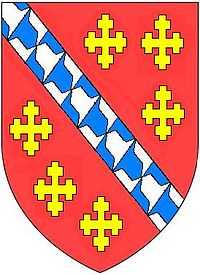


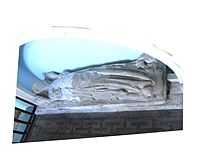
The early ancestry of the de Raleigh family of Devon, in its various forms,[8] has been studied in much depth, largely as a result of enquiries into the origins of the famous Elizabethan adventurer Sir Walter Raleigh, but no clear early pedigree has emerged.[9] Except where it quotes documentary sources, the Heralds' Visitations of Devon have been proved unreliable as regards the early family pedigree, and starts with the vague entry "Walter de Raleigh, slain at the Battle of Hastings", which person is not amongst the Proven Companions of William the Conqueror. However some isolated surviving references to members of the de Raleigh family may be connected to the Pilton family with near certainty. Sir Hugh de Raleigh, knight, was Sheriff of Devon 1160-1167 and held three knight's fees of the Feudal Barony of Barnstaple, and held half a knight's fee of Robert, Duke of Normandy.[10] In 1167 he was granted by King Henry II the manor of Nettlecombe in Somerset.[11]
The Lay Subsidy Return of 1332 records John de Raleigh assessed 12 pence.[12] The left-most (western-most) of a pair of early 14th-century stone effigies of cross-legged knights, which posture is commonly supposed to represent a crusader, exists in the south ambulatory of Exeter Cathedral, often said to represent a certain "Sir Henry de Ralleigh", who died in 1301.[13] The antiquarian John Leland visited the Cathedral in 1542 and recorded the knight as a Chichester, probably on the basis of the checquy arms which were then visible on his shield, and which were also noted by Sir George Carew in his 1588 work on the heraldry of Devon. Sir William Pole (1561–1635) recorded the arms on the knight's shield as: "Checque or and geules, a chief verry", and identified them as "of Ralegh of Ralygh".[14] No trace remains of the painted arms in 2013. The arms blazoned for "Henri de Ralle" on the following mediaeval rolls of arms: Dering Roll (185), St George's Roll (E406), Heralds' Roll (HE317), Charles' Roll (F207)[15] are Gules crusilly or, a bend vair, which are the arms shown as the second quartering of ten on an escutcheon on top of the monument to Sir John Chichester (d.1569) in Pilton Church, and also shown as impaled by Chichester painted on a stone escutcheon in a strapwork surround on the base of the monument.[16] The family history by Sir Alexander Chichester, Bart., however states the arms of Raleigh to have been inherited by the Chichesters: Chequy or and gules a chief vair, which replaced their ancient arms of Ermine, a canton sable [17] This assertion seems to be validated by the form of the arms on the seal in black wax of Sir John de Raleigh attached to the deed dated 1362 now in the North Devon Record Office, the catalogue entry for which is quoted below. The de Raleigh family also held the manor of "Auvrington" (Arlington, Devon), as recorded in the Book of Fees, held from the overlord Philip de Culumbars (d.1342), of Nether Stowey, 2nd husband of Eleanor FitzMartin, sister and one of two co-heiresses of William II FitzMartin (d.1326), feudal baron of Barnstaple.[18] Arlington was thus also inherited by the Chichesters from de Raleigh. The pedigree given in Vivian's Visitation of Devon is as follows:
- Walter I de Raleigh, slain at the Battle of Hastings, married Beatrix who gave one carucate of land in Raleigh to Battle Abbey for the repose of the soul of her late husband.
- Walter II de Raleigh of Pilton, Devon (son)
- Walter III de Raleigh, (son), fl temp. Kings William II (1087-1100) and Henry I (1100-1135)
- Sir Hugh de Raleigh, (eldest son), Sheriff of Devon 1160-1167, married the daughter of Robert Duke of Normandy, bastard son of King Henry II. He had a son Sir Simon de Raleigh, who died without progeny and predeceased his father. He granted the manor of Nettlecombe in Somerset to his younger nephew Warine de Raleigh.
- Richard de Raleigh (brother)
- William I de Raleigh (son) (alias "son of Hugh).[19]
- Sir William II de Raleigh (eldest son), temp King John (1199-1216), who left no progeny
- Peter (or Robert) de Raleigh (brother), married Margaret Daubeny, daughter of Sir Philip Daubeny.
- Sir William III de Raleigh (son), Judge of the King's Bench, married Joan Stockhay, the daughter and co-heiress of Sir John Stockhay.
- Sir Thomas Raleigh (son), fl. temp. King Henry III (1216-1272)
- Sir Walter Raleigh (eldest son), "a famous soldier", married Sybilla de Umfraville, daughter of Gilbert de Umfraville by his wife Mawde, Countess of Angus. He died without progeny.
- Sir John Raleigh (brother), married Joan Tracy, daughter of Sir Henry Tracy.
- Sir William IV Raleigh (son), married firstly Beatrix Shandos, daughter of Sir Robert Shandos; secondly to Margaret Botreaux, daughter of Sir William Botreaux.
- Sir John Raleigh (son from 1st marriage), married Joan Pettit, daughter of Sir Henry Pettit. His son Sir Henry Raleigh died without progeny and apparently predeceased his father.
- Thomasine Raleigh (daughter and sole heiress), married firstly Sir John Chichester; secondly Sir William Talbot. Her Inquisition post mortem states that she died on the Monday following the feast of St Peter ad Vincula, 1402.[20] A very worn stone effigy of a lady, said by Pevsner to be from the 14th century, exists in Arlington Church, under a low arch recessed into the north wall of the chancel. Lysons (1822) [21] suggested this represented "a female of the Raleigh family", and it may therefore represent Thomasine. In the archives of the Chichester family of Arlington Court (a younger branch descended in the 16th century from Chichester of Raleigh), held at the North Devon Record Office, is the following deed in Latin, dated 31 Jan. 1362, involving the transfer by him of all Sir John de Raleigh's lands to feoffees, all trusted local clerics. This deed was clearly retained by the Chichesters in their muniments chest as proof of their title to the estate of Arlington, together with all their other deeds, as was customary in the days before registration of title at the Land Registry:[22]
Latin deed of 31 January 1362 sealed by Johannes de Ralegh. North Devon Record Office 50/11/1/1"Feoffment and grant of advowson John de Raleghe to Master Pyllond (probably of the de Pilland family, lords of the manor of Pilland, in the parish of Pilton), chaplain, Robert, parson of the church of Lokysore (Loxhore), Philip of Loccombe, parson of the church of Alryngton (Arlington), Henry de Lamare, parson of the church of Mortaho (i.e. Mortehoe): Manors of Raleghe, Alryngton with the advowson of the church of Alryngton, Lokysore with the advowson of the church of Lokysore, Cholecombe (i.e. Challacombe) with the advowson of the church of Cholecombe, Westdonne (i.e. West Down, Devon), Beggherhewys (Beggearn Huish in Watchet, Somerset) and Donne Were (Dunwear, Somerset[23]); and also the fealty, rents and services of John de Sully, chev(alier)r, and his wife, which they owe for the manor of Rokysforde (Ruxford, in Sandford) which they hold for their lives. All the above manors to be held with all their appurtenances for ever. Witnesses: John de Sully, chev', [for chevalier knight], Thoebald Greynwyle, chev' (Grenville,? lord of the manor of Bideford), Richard de Merton', chev', Richard Beamond (Beaumont,? of Shirwell), William de Loftote, Date: Raleghe, on the last day of January in the 36th year of the reign of Edward III (i.e. 31 Jan. 1362); Seal: Round, black, armorial seal, of John de Raleghe, pendant on parchment tag, broken [Chichester arms actually]"Seal of John de Raleigh as affixed to his deed of 31 January 1362 (North Devon Record Office 50/11/1/1). The arms shown are those apparently later adopted by the Chichesters: Checquy a chief vair. Legend: SIG(ILLUM) JOH(ANN)IS ......("Seal of John .....)
Most of these priests would have been appointed to their benefices by John de Raleigh himself or his ancestor, as most were incumbents of de Raleigh manors (Loxhore, Arlington and Challacombe). The chaplain may have served the private family chapel within the manor house of Raleigh. Effigies of Sir John de Sully (1282-1388), KG, and his wife Isobel exist in Crediton Parish Church. Sully was lord of the manor of Iddesleigh, but was said by Westcote (d.circa 1637) to have had his seat at "Rookesford, lately the land of Chichester and alienated to Davye", i.e. Ruxford, in the parish of Sandford about 1/2 mile north-west of Crediton.
Chichester
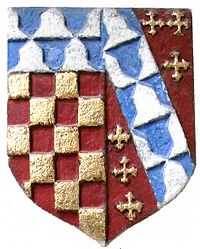
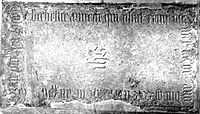
A pedigree of the Chichester family was compiled in 1871 by Sir Alexander Palmer Bruce Chichester, 2nd Baronet of Arlington Court (1842-1881), ("History of the Family of Chichester"), and gives six generations of the family prior to their inheritance of the manor of Raleigh, all of which differ from the names of the eight generations listed in the official Heralds' Visitations. Vivian published his 1895 edition of the Visitations in parallel with Sir Alexander's pedigree on the same page for comparison.[26] Both versions however are largely in agreement on the descent of the family after John Chichester who married Thomasine de Raleigh:
- John I Chichester married in about 1365[27] Thomasine de Raleigh (d.1402), daughter and heiress of Sir John De Raleigh. He was lord of the manors of Treverbin in Cornwall and of Beggerskewish and Donwer in Somerset.[28] According to Sir Alexander Chichester, Bart., he was the son of Sir Roger Chichester, who was knighted in 1346 at the Siege of Calais and later fought at the Battle of Poitiers in 1356.[29] According to the Heralds' Visitation of Devon his father was John Chichester, 7th in descent from Walleran de Cirencester alias Chichester, himself descended from a brother of Robert of Chichester, Bishop of Exeter in 1155-1160. According to the Ledger Book of Tor Abbey, in 1237 Walleran did homage to William de Raleigh for the manor of South Pool.[30]
- Sir John II Chichester (1385-1437)[31] (son), who fought in the Battle of Agincourt (1415) in the retinue of the Sieur de Harrington. He married Alice Wotton, daughter and co-heiress of John Wotton of Widworthy. He survived his wife and died 14 December 1437.[32]
- Richard Chichester (1423-1496), (son), was a minor aged 14 on his father's death. He served as Sheriff of Devon in 1469 and 1475. He married firstly Margaret Keynes, daughter of Nicholas Keynes of Winkleigh; secondly Elizabeth Sapcott (d.1502), who survived him, daughter of Sir John Sapcott. He died 25 December 1496[33] and his Inquisition post mortem was taken in 1498. His tomb slab exists set into the floor of the chancel aisle of Pilton Church. Their second son Richard Chichester married Thomasine de Hall (d.1502),[34] the heiress of Hall, in the parish of Bishops Tawton, and founded that line of the family, whose descendants (in a female line) still own the estate in 2012. His heir was his grandson John Chichester (d.1537/8). He was predeceased by both his sons:
- John Chichester (d.1477) (eldest son by Margaret Keynes), married Thomasine Steyning, who survived him, daughter of William Steyning. Predeceased his father, died without issue.
- Nicholas Chichester (c. 1447 - before 1496),[35] (younger son by Margaret Keynes and heir to his brother), married Christine Paulet
- Sir John Chichester (c. 1474-1537) (son and heir of Nicholas Chichester (d.pre-1496) and heir to his grandfather), married firstly in about 1490, Margaret Beaumont (d.1507), daughter and co-heiress of Hugh Beaumont of Shirwell by his wife Thomasine Wise. Secondly Joan Brett, sister of Robert Brett (d.1540), lord of the manor of Pilland in the parish of Pilton, and the last steward of Pilton Priory before its dissolution[36] and widow of John Courtenay (d.1510) of Molland; she survived her husband and remarried Henry Fortescue. His will was witnessed by his brother-in-law Robert Brett (d.1540). The manorial account book for Raleigh of the year 1506/7 survives.[37] His eldest son by his second wife Joan Brett was Amyas Chichester (1527-1577), to whom he granted his manor of Arlington, and who established that line of the family, created Chichester Baronets of Arlington Court in 1840.
- Sir John Chichester (c. 1516/22-1569), (grandson), MP, Sheriff of Devon 1552 and 1557. He was the son of Edward Chichester (c. 1496-1522) (second and eldest surviving son of Sir John Chichester (c. 1474-1537), whom he predeceased) by his wife Lady Elizabeth Bourchier (d.24 August 1548), a daughter of John Bourchier, 1st Earl of Bath (1470–1539). Lady Elizabeth's monumental brass, depicting a small kneeling figure with separate inscription, exists in St Brannock's Church, Braunton, Devon.[38] Sir John Chichester's elaborate monument (without effigy) exists in Pilton Church. He married Gertrude Courtenay, a daughter of Sir William Courtenay (1477–1535) of Powderham. He obtained from the crown (after having been leased to Richard Duke (d.1572), of Otterton) the rectory, parsonage, glebe, tithes oblations and advowson of the former Pilton Priory, after the Dissolution of the Monasteries. He bequeathed these to his son and heir in his will.[39] These rights had passed under another lease to George Turrell by 1591.[40]
- Sir John Chichester (1549-1586) (eldest son), of Raleigh. Married Anne Denys, daughter of Sir Robert Dennis of Holcombe Burnell.
- Sir Robert Chichester (1578-1627) (son). His monument with kneeling effigies of himself and his two wives exists in Pilton Church. He married firstly Frances Harrington (d.1615), who received a stately funeral in Pilton church attended by many eminent persons.[41] She was the daughter of John Harington, 1st Baron Harington of Exton (1539-1613) and a co-heiress of her brother John Harington, 2nd Baron Harington of Exton (1592-1614). By her he had a daughter Anne Chichester who married Thomas Bruce, 1st Earl of Elgin (1599-1663). Secondly he married Ursula Hill, daughter of Robert Hill of Shilston. In 1599 he purchased from Robert Dillon Esq., of Chumhill, Bratton Fleming, the husband of his aunt Grace Chichester, for £9,900 the manors of "Bratton Flemyng, Benton, and Haxton, the capital mansion, barton and demesnes of Chumhill, Haxton, Chelfham, and Shirrledon and all the lands called Chumhill, Benton, Haxton, Chelfham, and Shirrldon, in the parishes of Bratton Flemyng, Loxhore, Stoke Rivers, and Kentisbury, and £5 of rent (called Flemyng's rent) out of lands in South Molton and elsewhere in Devon".[42]
- Sir John Chichester, 1st Baronet (1623-1667) (son by 2nd wife Ursula Hill)
- Sir John Chichester, 2nd Baronet (c. 1658-1680) (son), died without progeny.
- Sir Arthur Chichester, 3rd Baronet (c. 1662-1718) (brother). In 1689 [43] he moved permanently to Youlston Park in the parish of Shirwell, long owned by the family and used as a second seat, inherited by Sir John Chichester (c. 1474-1537) from his first wife Margaret Beaumont (d.1507), and sold the manor of Raleigh to Arthur Champneys, MP for Barnstaple in 1701 (1695-c. 1715) and a Barnstaple merchant.[44] On 2 November 1715 however he was back at Pilton where together with Henry Incledon, Esq., he received the oaths, declarations against trans-substantiation and administered the sacramental tests respecting 36 local gentlemen.[45]
Champneys
Arthur Champneys sold Raleigh in 1703 to Sir Nicholas Hooper, his fellow MP for Barnstaple in 1701.[46] His son Nicholas Hooper rebuilt Raleigh House on an adjacent site slightly higher up the hill. Nicholas Hooper's heir was his sister Elizabeth Hooper (d.1726), who married John Bassett (1683-1721), of Heanton Punchardon, MP for Barnstaple 1718-1721. In the return to the Dean Milles' Questionnaire of about 1745, the manor house of Raleigh was described as "Rawleigh in Ruins",[47] in response to the question "Are there any gentlemen's seats and remarkable improvements in the parish?".
Bassett
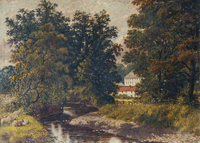
In 1793 Francis Bassett, who never lived at Raleigh,[48] sold some land in Raleigh to Robert Newton Incledon[49] Incledon sold land in Raleigh in 1885, which was resold in 1894 and again in 1919.[50] In the mid-18th century John Bassett Esq., was the last person to live in the Old Manor House, and appointed Rev. George Foss as chaplain to the private chapel.[51]
Various
The 1843 tithe award showed manor of Raleigh held between three owners:
- William Arundel Yeo, 147 acres
- Robert Newton Incledon, who held together with William Hodge 160 acres.
- William Hodge, who held together with Robert Newton Incledon 160 acres.
In 1862 Raleigh House was occupied by Murray William Mathews and his wife Matilda Jane Mathews, in which year they leased out land and a plantation.[52]
Sources
- Reed, Margaret, Pilton its Past and its People, Barnstaple, 1985, (First published 1977). Especially pp. 28–31
- Vivian, J.L., Lt.-Col., The Visitations of the County of Devon comprising the Heralds' Visitations of 1531, 1564 & 1620, Exeter, 1895
- www.tudorplace.com (pedigree of Chichester family)
Further reading
References
- ↑ Identification per Orme, Nicholas, "Whose Body?", published in "The Cathedral Cat, Stories from Exeter Cathedral", 2008, p.25, who identifies Raleigh as the left-most (western-most) of two similar effigies. Pevsner, Buildings of England: Devon, 2004, p.381 identifies him as the right-most
- ↑ Orme, p.27, based on Little, A.G., & Easterling, R.C., The Franciscans and Dominicans of Exeter, History of Exeter Research Group, Monograph no.3, Exeter, 1927, pp.40-5, 67-75
- ↑ Lysons, Magna Britannia, Vol.6, Devon, 1822
- ↑ Thorn, Caroline & Frank (Eds.), Domesday Book, Vol.9, Devon, Chichester, 1985, chap. 3
- ↑ Thorn, Caroline & Frank (Eds.), Domesday Book, Vol.9, Devon, Chichester, 1985, chap. 3
- ↑ The Heralds' Visitation of Devon in the section on "Chichester of Raleigh" (Vivian, p.172, note 6) states that these chequy arms were the arms of the de Raleigh family assumed by the Chichesters following their marriage to the Raleigh heiress and that the former arms of Chichester ("ancient")were Ermine, a canton sable. The Visitation however contradicts itself later where under the section "Raleigh of Fardell",(Vivian, p.638) which shows the marriage of Thomasine to Sir John Chichester, the arms of Raleigh are given as depicted above, Gules crusilly or, a bend vair
- ↑ The arms actually used on the seal of Sir John de Raleigh on his deed of 1362 are the arms apparently later adopted by the Chichesters: Checquy a chief vair (see below)This theory as to the arms of each family is that suggested by Sir Alexander Chichester, Bart., in his History of the Family of Chichester, also noted in Vivian, 1895, p.172, note 6
- ↑ Sir William Pole identified six different families, with different arms, but all possibly having a common source from the Pilton family, having split-off before the start of the age of heraldry (c. 1200-1215)
- ↑ See e.g. Brushfield, T.N., FSA, "Raleghana Part III, Remarks on the Ancestry of Sir Walter Raleigh, read at Totnes, August, 1900
- ↑ Visitation of Devon, p.638
- ↑ Visitation of Devon, p.638
- ↑ Reed, p.215
- ↑ Orme, p.25
- ↑ Quoted in Orme, Nicholas, "Whose Body?", published in The Cathedral Cat, Stories from Exeter Cathedral, 2008, p.20
- ↑ Source: Brian Timms Website
- ↑ Reed, Margaret, Pilton its Past and its People, Barnstaple, 1977, p.244, gives erroneous arms for Raleigh of Pilton as the arms of the family of Sir Walter Raleigh, the Elizabethan adventurer, namely: Gules, five fusils conjoined in bend argent
- ↑ Visitations of Devon, p.172, Chichester of Raleigh
- ↑ Thorn, Vol.2, chap38,1, quoting "Fees, p.782"
- ↑ Vivian, p.638, note 1: per Harl MS 5840, f.125
- ↑ Inquisition post mortem 5 Henry IV (1403), no.36, quoted by Vivian, p.172
- ↑ Lysons, Magna Britannia, Vol.6, Devon, 1822
- ↑ Archives of the Chichester family of Arlington Court, North Devon Record Office: PILTON, ARLINGTON, LOXHORE, CHALLACOMBE, SANDFORD?, WEST DOWN, all in Devon BAGGEARN HUISH, DUNWEAR, in Somerset 50/11/1/1 31 Jan. 1362 36 Edward III
- ↑ Victoria County History, Somerset, Vol.6, 1992, Bridgwater: Manors and other estates: Andersfield, Cannington, and North Petherton Hundreds (Bridgwater and neighbouring parishes) pp. 208-213. : "The manor (of Dunwear) was held of John de Columbers as 1 knight's fee in 1284-5 and as ½ knight's fee in 1303, and in 1569 and 1627 was held of the Columbers heir as of Nether Stowey manor (i.e. feudal barony of Nether Stowey). In 1236 William de Raleigh held Dunwear in demesne, Thomas de Raleigh in 1284-5 and 1303, Lucy de Raleigh in 1316, and Thomas de Raleigh before 1342. Thomas's unnamed heirs were lords in 1346. Possibly from then and certainly from 1402 Dunwear manor descended with Beggearn Huish in Nettlecombe, and the Chichesters retained it when they sold Beggearn Huish in 1604. Sir Robert Chichester, K.B., died in 1627 owning both North Bower and Dunwear and leaving a son John, a minor. John (cr. Bt. 1641) seems to have mortgaged or sold both manors in 1660, (fn. 32) and no further trace of either manor has been found"
- ↑ The Heralds' Visitation of Devon in the section on "Chichester of Raleigh" (Vivian, p.172, note 6) states that these were the arms of the de Raleigh family assumed by the Chichesters following their marriage to the Raleigh heiress and that the former arms of Chichester ("ancient") were Ermine, a canton sable. The Visitation however contradicts itself later where under the section "Raleigh of Fardell", (Vivian, p.638) which shows the marriage of Thomasine to Sir John Chichester, the arms of Raleigh are given as depicted above, Gules crusilly or, a bend vair
- ↑ Heralds' Visitations of Devon, ed. Vivian, 1895, p.172, footnote 6
- ↑ Vivian, p.172, notes 1 & 2
- ↑ Debrett's Peerage, 1967
- ↑ Vivian, Visitation of Devon, p.172
- ↑ Vivian, Visitation of Devon, p.172; Debrett's Peerage, 1967
- ↑ Vivian, Visitation of Devon, p.172
- ↑ The Inq.p.m. of Thomasine Raleigh stated her son John to be aged 17 at her death in 1402 (quoted by Vivian, p.172)
- ↑ Inq.p.m. 16 Henry VI, no.55
- ↑ Vivian, p.172
- ↑ Vivian, p.176 quotes date of Thomasine de Hall's death from her Inq.p.m which names her husband and father in law as "Richard Chichester". The pedigree on p.176 however gives her husband as the great-nephew of Richard Chichester (d.1496) of Raleigh, which seems unlikely from the dates
- ↑ Named as deceased in his father's Inq.p.m.
- ↑ Reed, Margaret, Pilton: its Past and its People, Barnstaple, 1985, p.175
- ↑ Recited in Reed, Appendix 3, p.216
- ↑ Pevsner, Devon, 2004, p.208
- ↑ Reed, p.49
- ↑ Reed, p.49
- ↑ Reed, p.45
- ↑ North Devon Record Office, 48/25/9/9, 2 June 1599
- ↑ Reed, Margaret A., Pilton, its Past and its People, Barnstaple, 1985, p.49
- ↑ Reed, Margaret A., Pilton, its Past and its People, Barnstaple, 1985, p.31
- ↑ Devon and Exeter Oath Rolls, 1723, QS17/1/13A/2e, Oaths sworn at Pilton, 2 November 1715 before Arthur Chichester Bart and Henry Incledon Esq.
- ↑ Reed, 1985, p.31
- ↑ Reed, p.5
- ↑ Reed, 1985, p.31
- ↑ Reed, 1985, p.31
- ↑ Reed, 1985, p.31
- ↑ Reed, p.66
- ↑ Document offered for sale by E-bay, item number: 270036928303."1862 INDENTURE, RALEIGH HOUSE ,PILTON, NORTH DEVON,LARGE VELLUM INDENTURE , DATED 5TH APRIL 1862, LEASE OF PLANTATION AND LAND BY MURRAY WILLIAM MATHEWS, RALEIGH HOUSE PILTON, NR BARNSTABLE, DEVON, MURRAY ALEXANDER MATHEWS OF TAUNTON, SOMERSET AND FREDERICK SMITH 19 ESSEX STREET, THE STRAND, LONDON, MIDDLESEX, WITNESSED BY MATILDA JANE MATHEWS ALSO OF RALEIGH HOUSE, PILTON ,DEVON.



